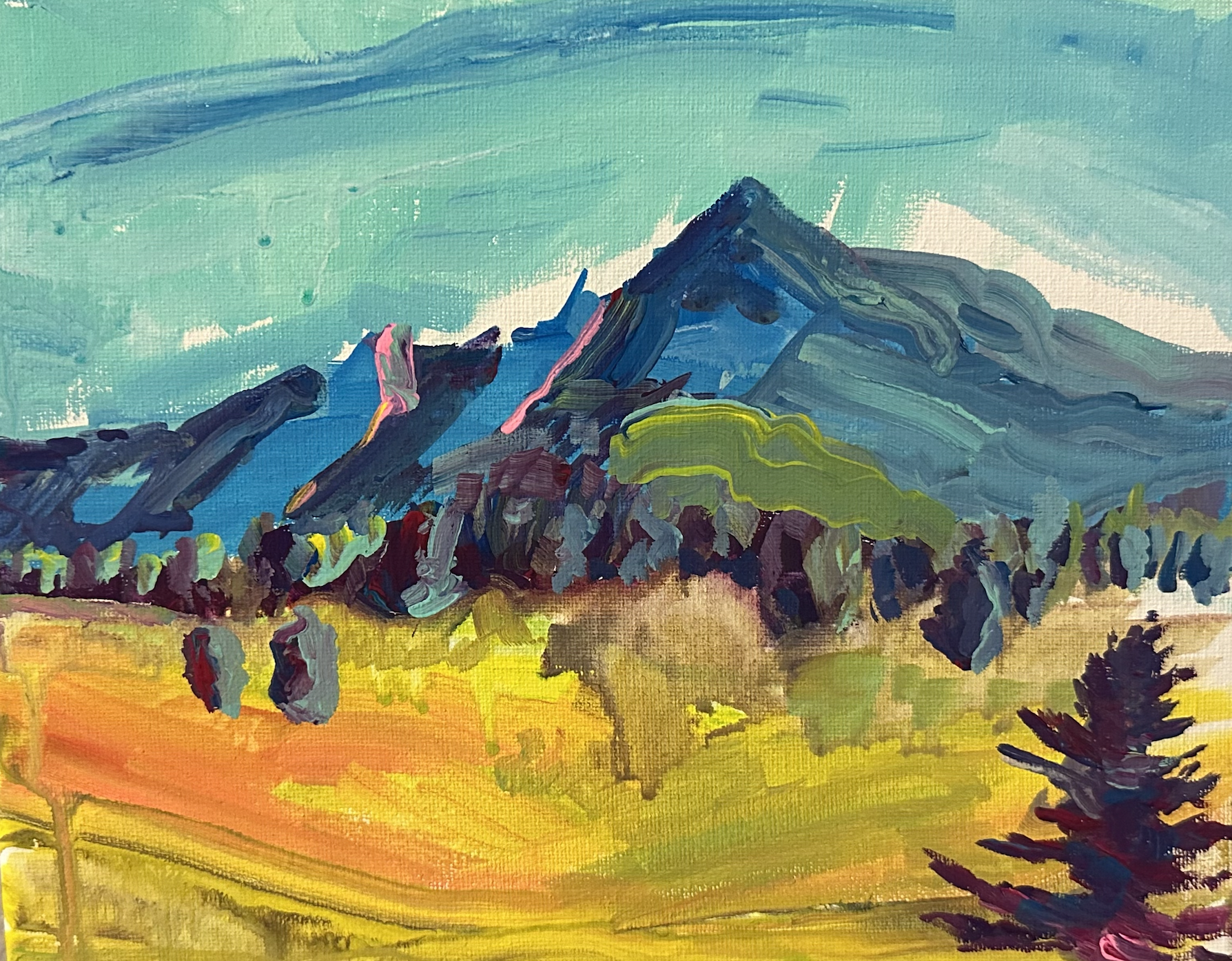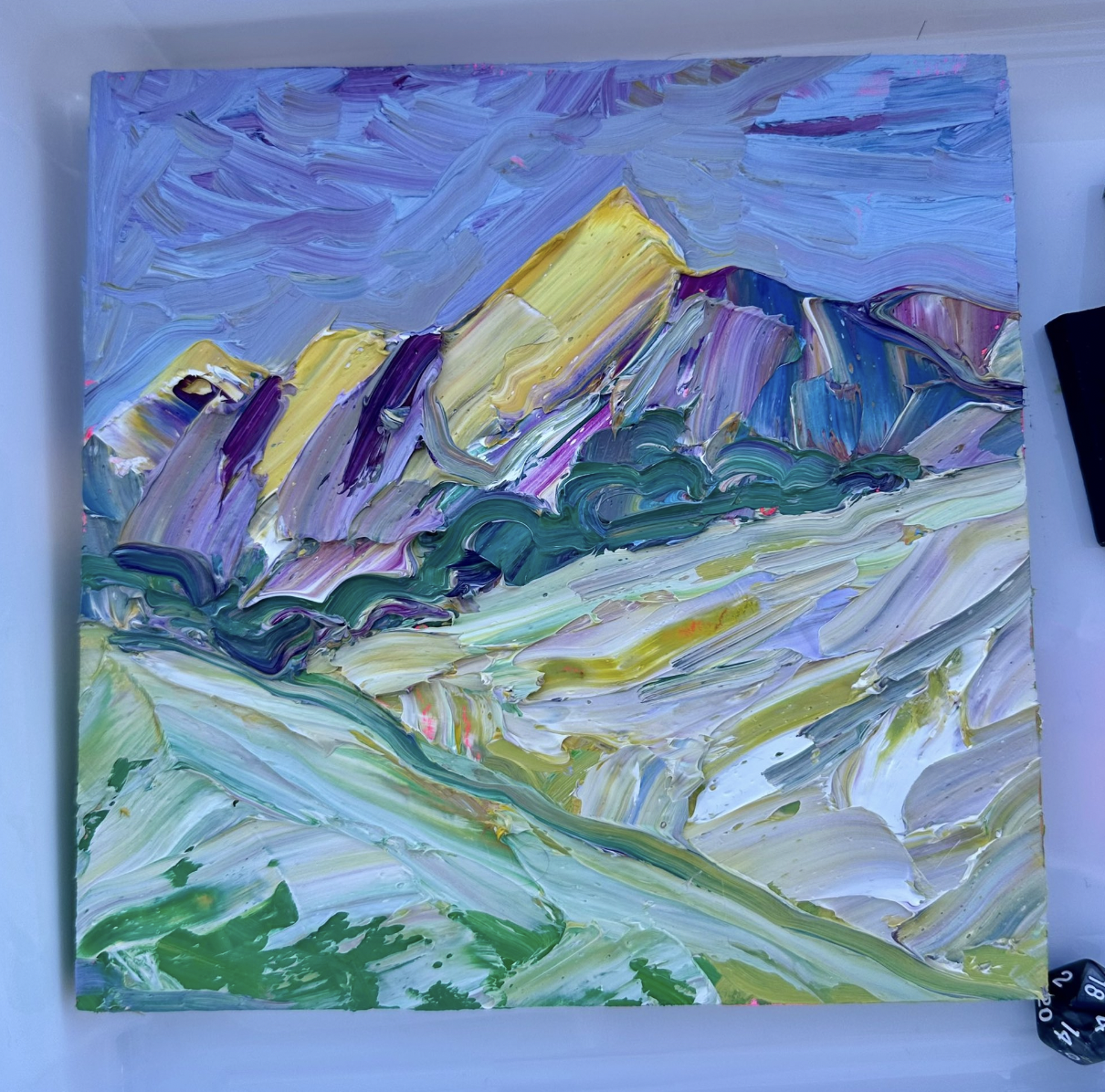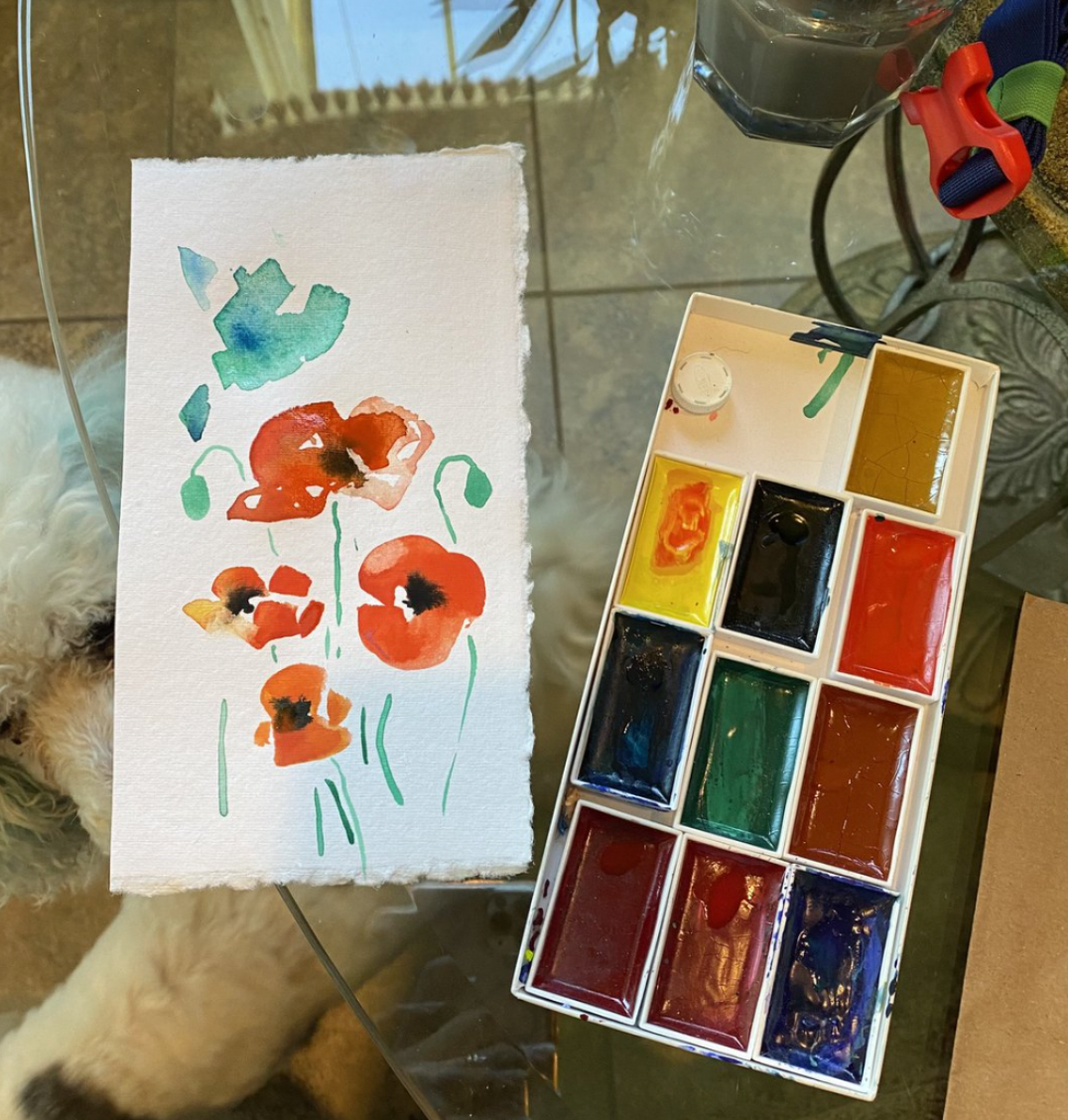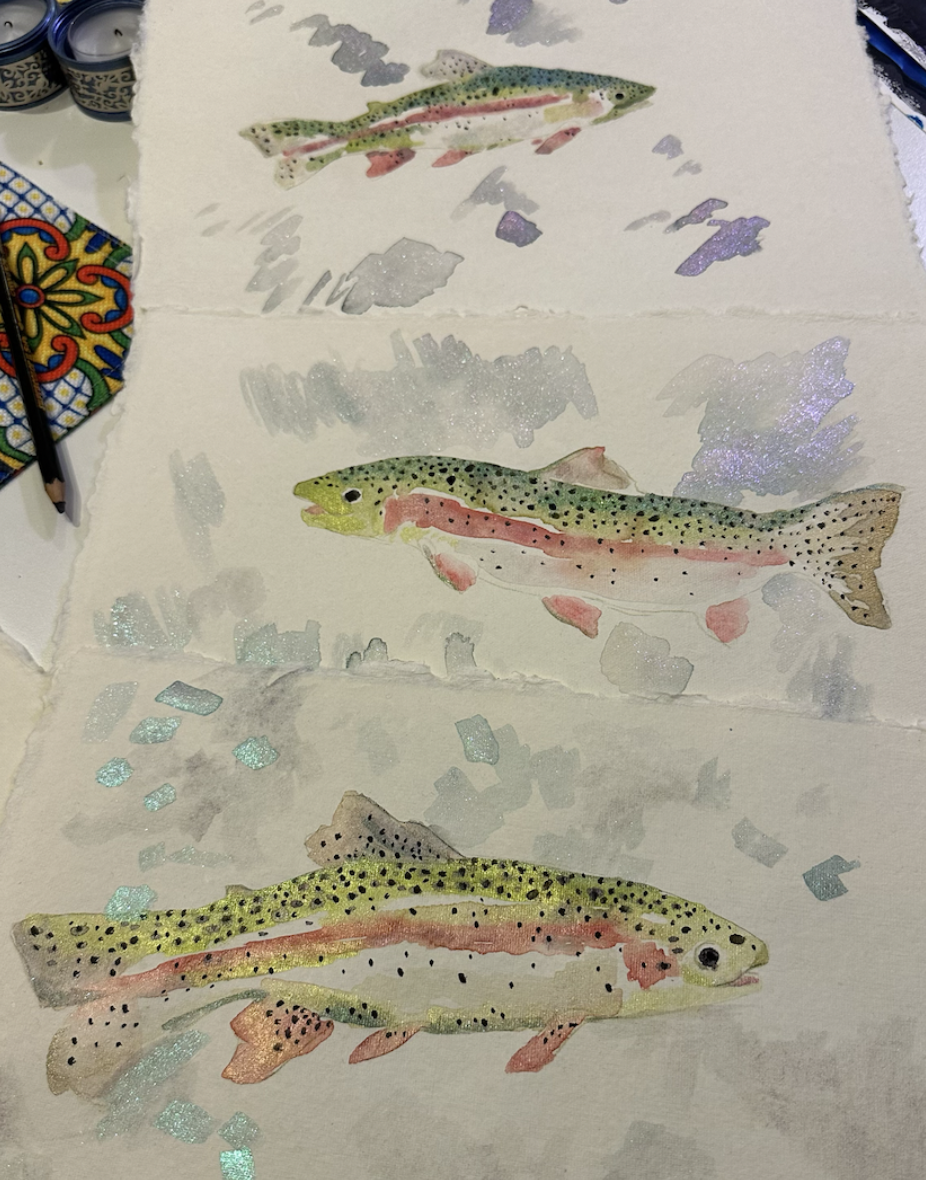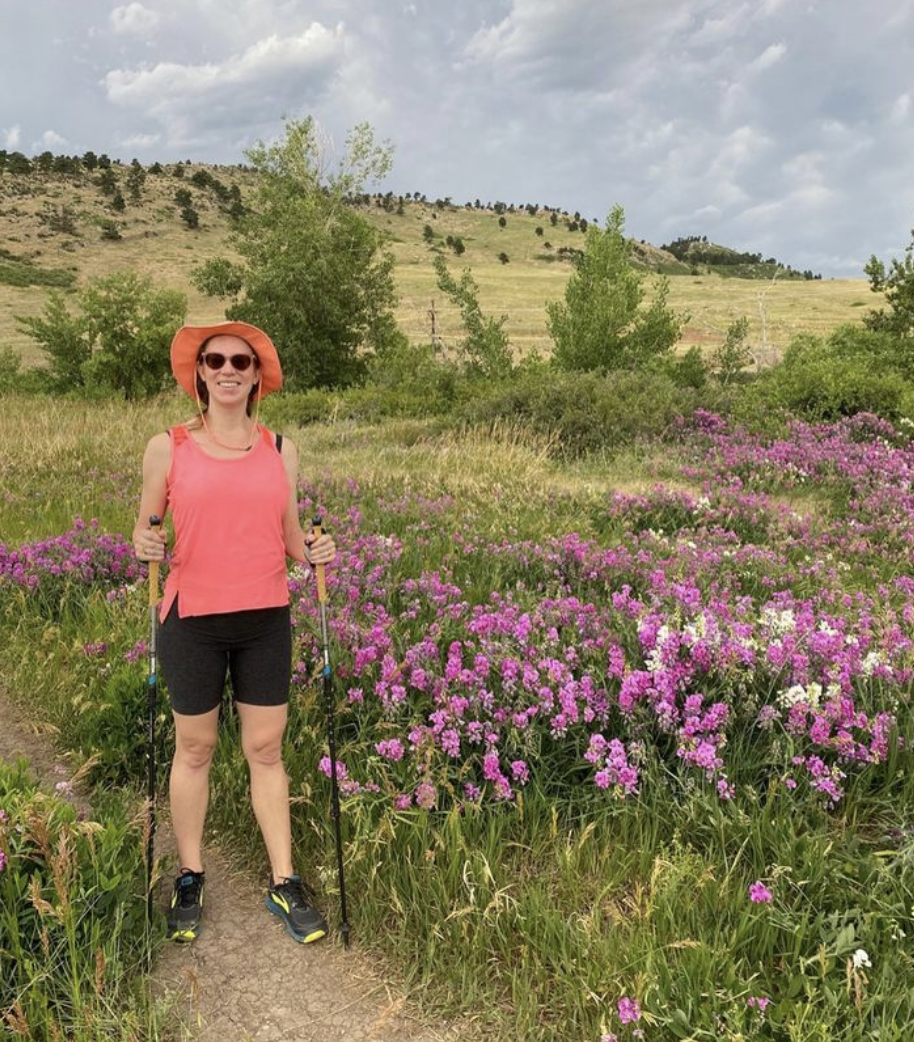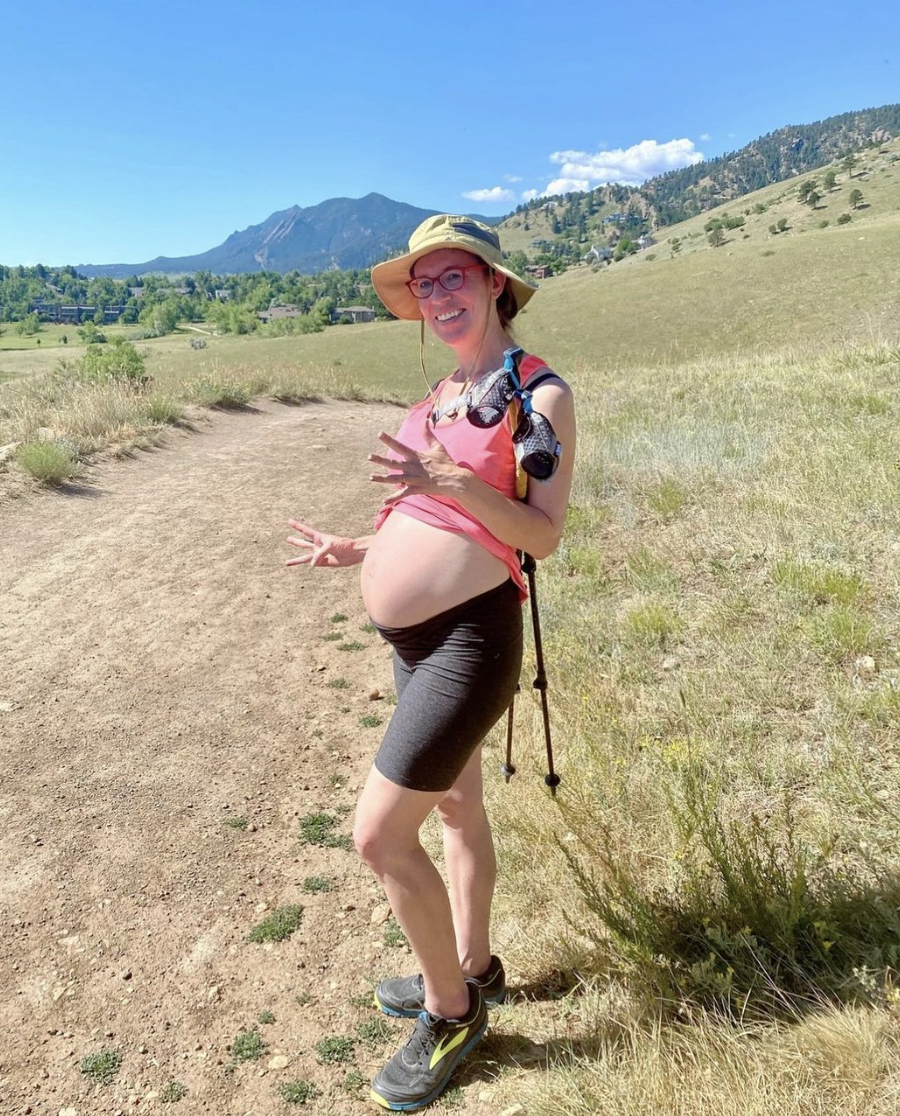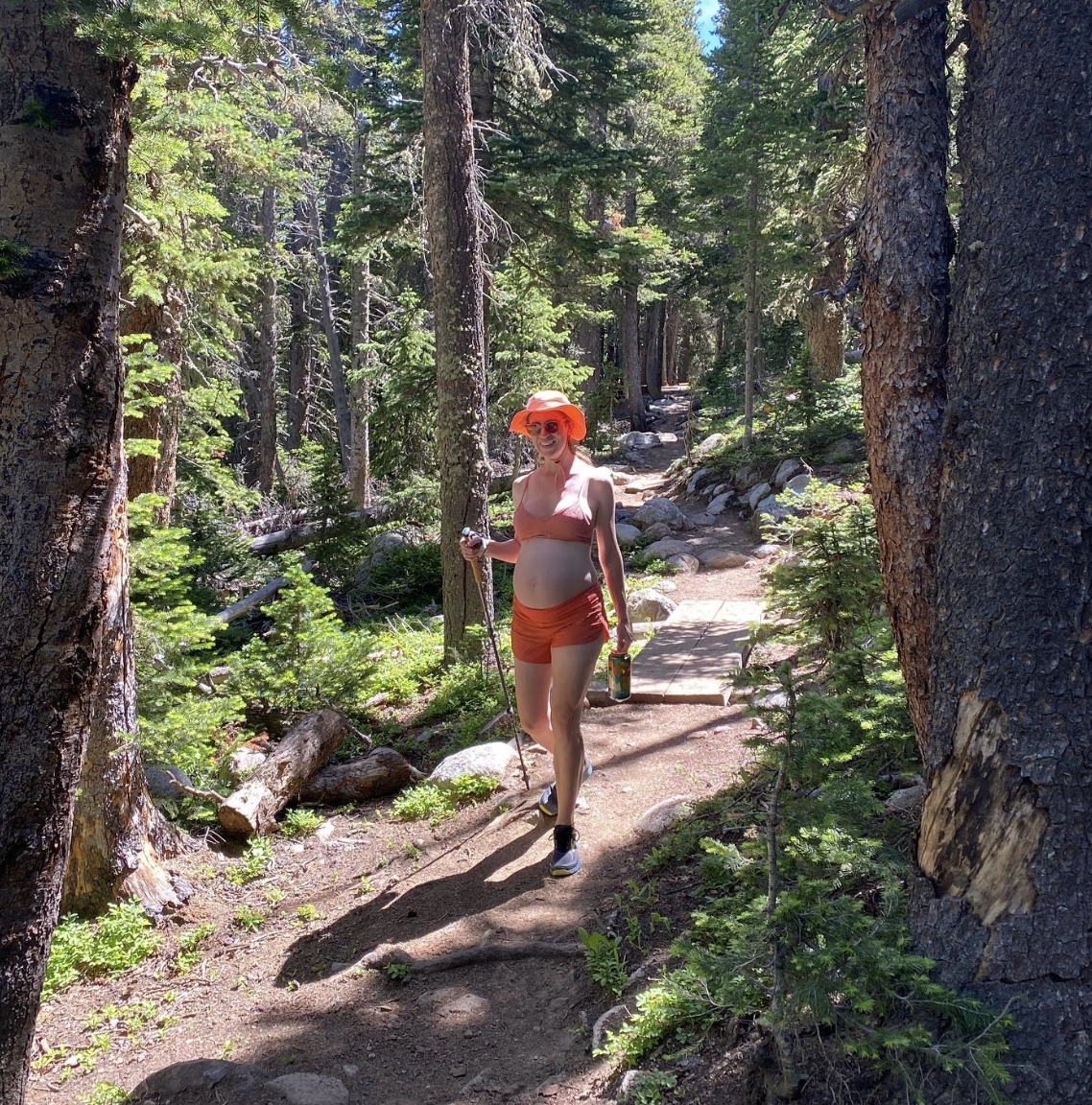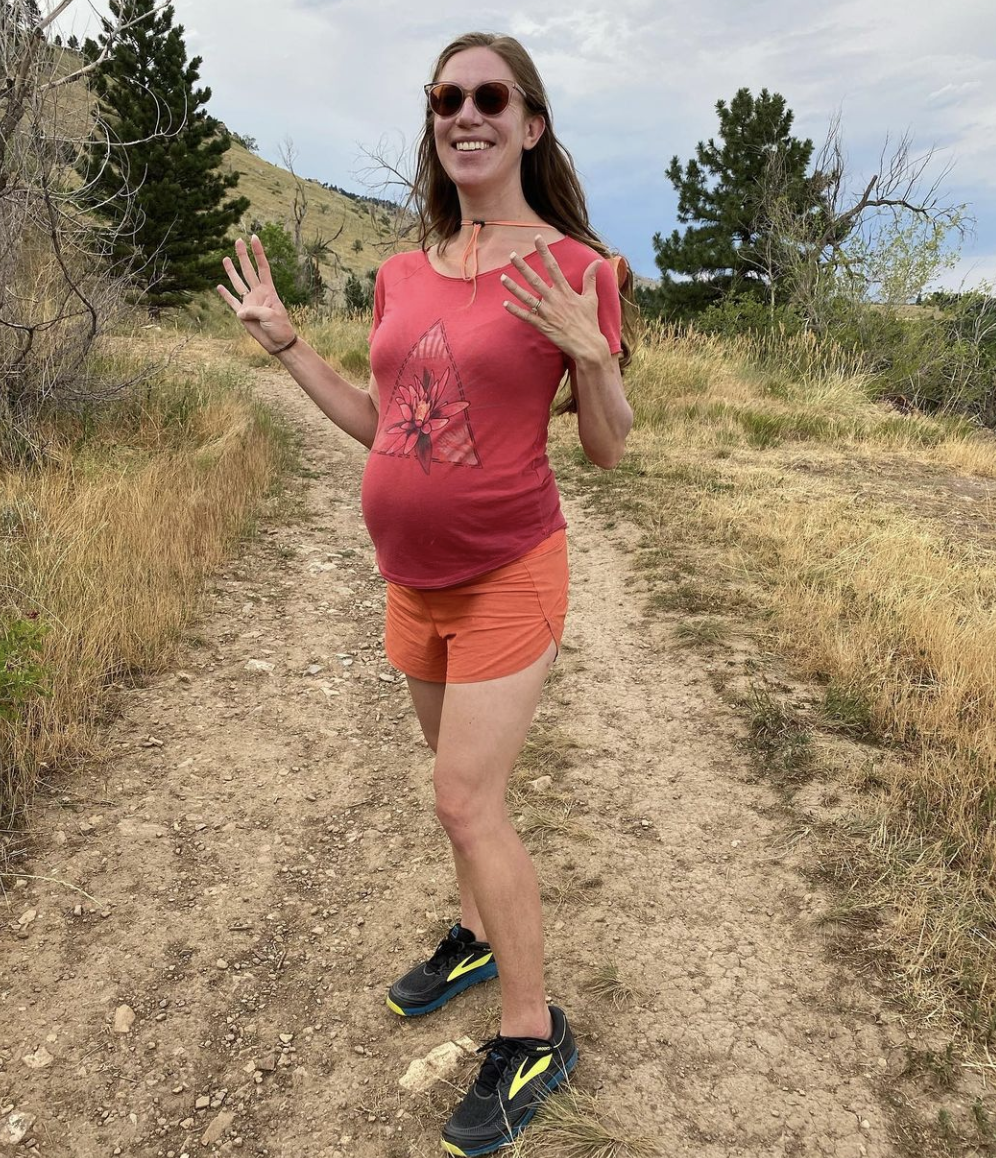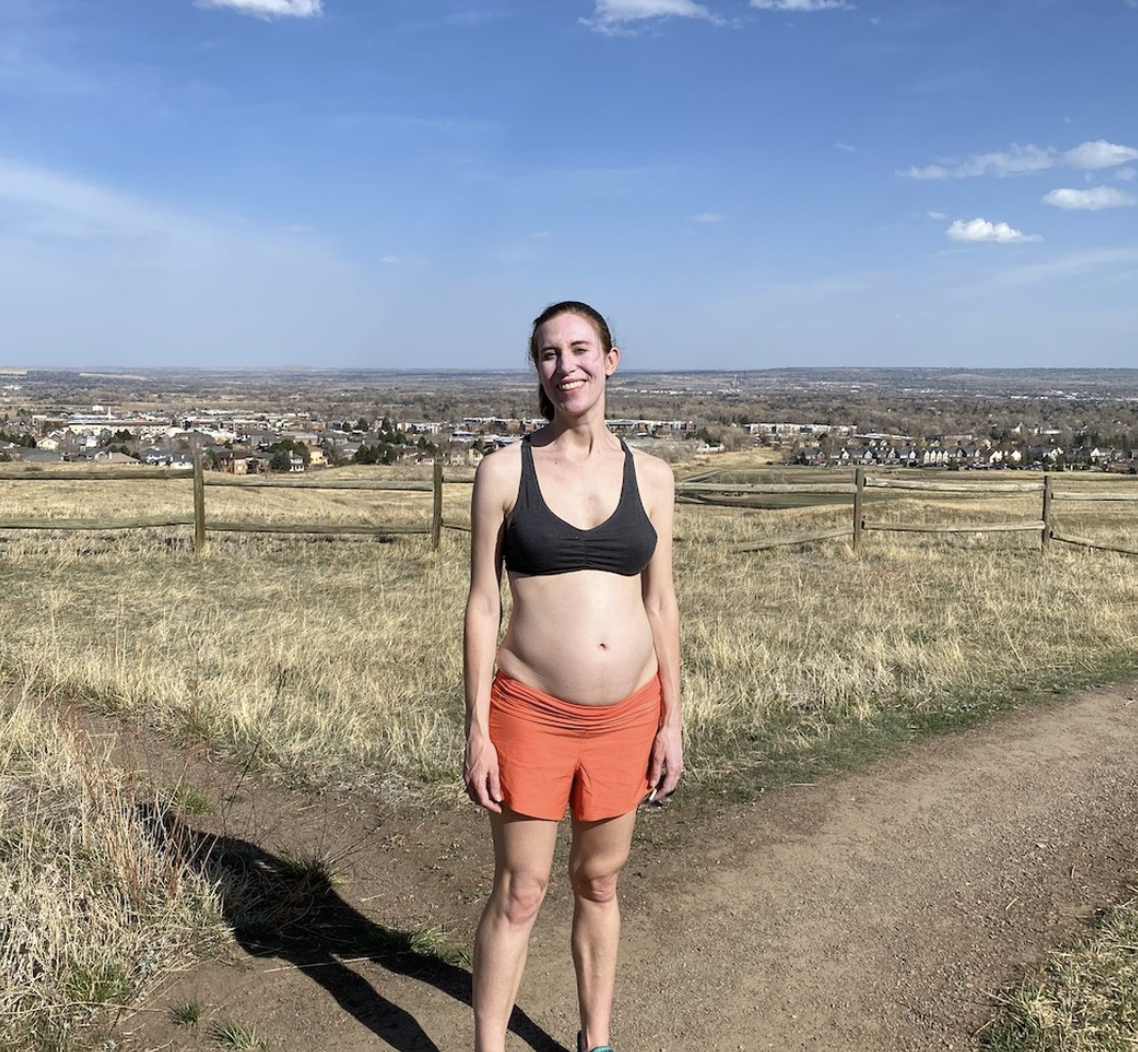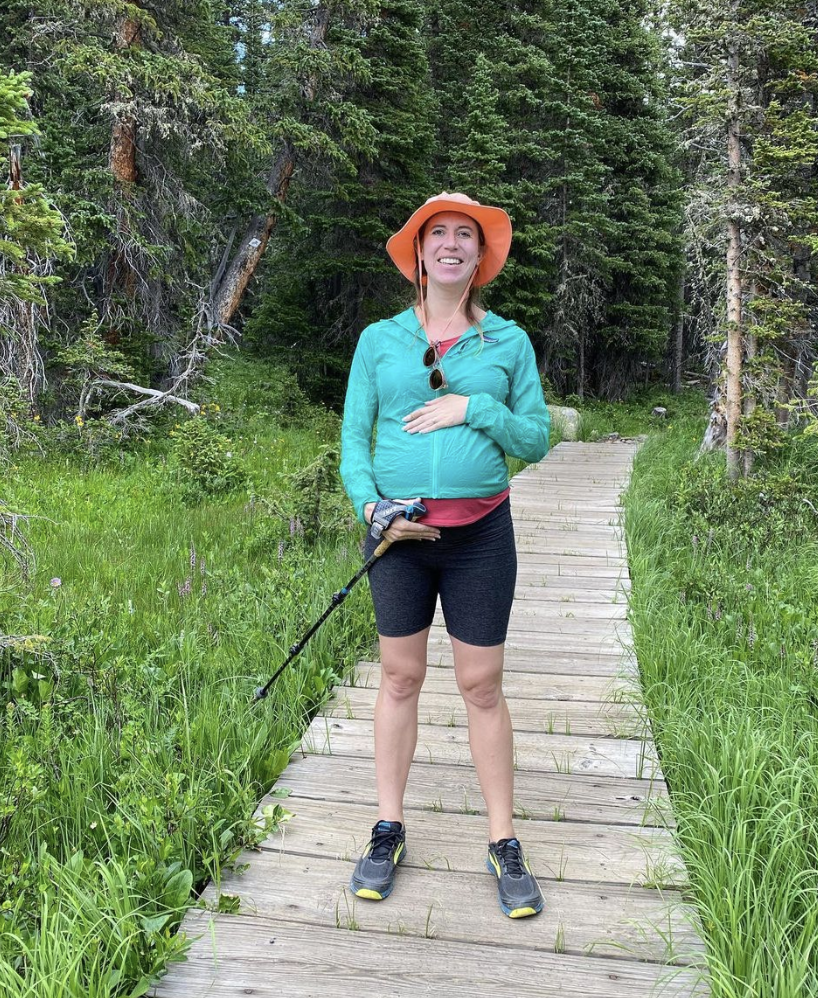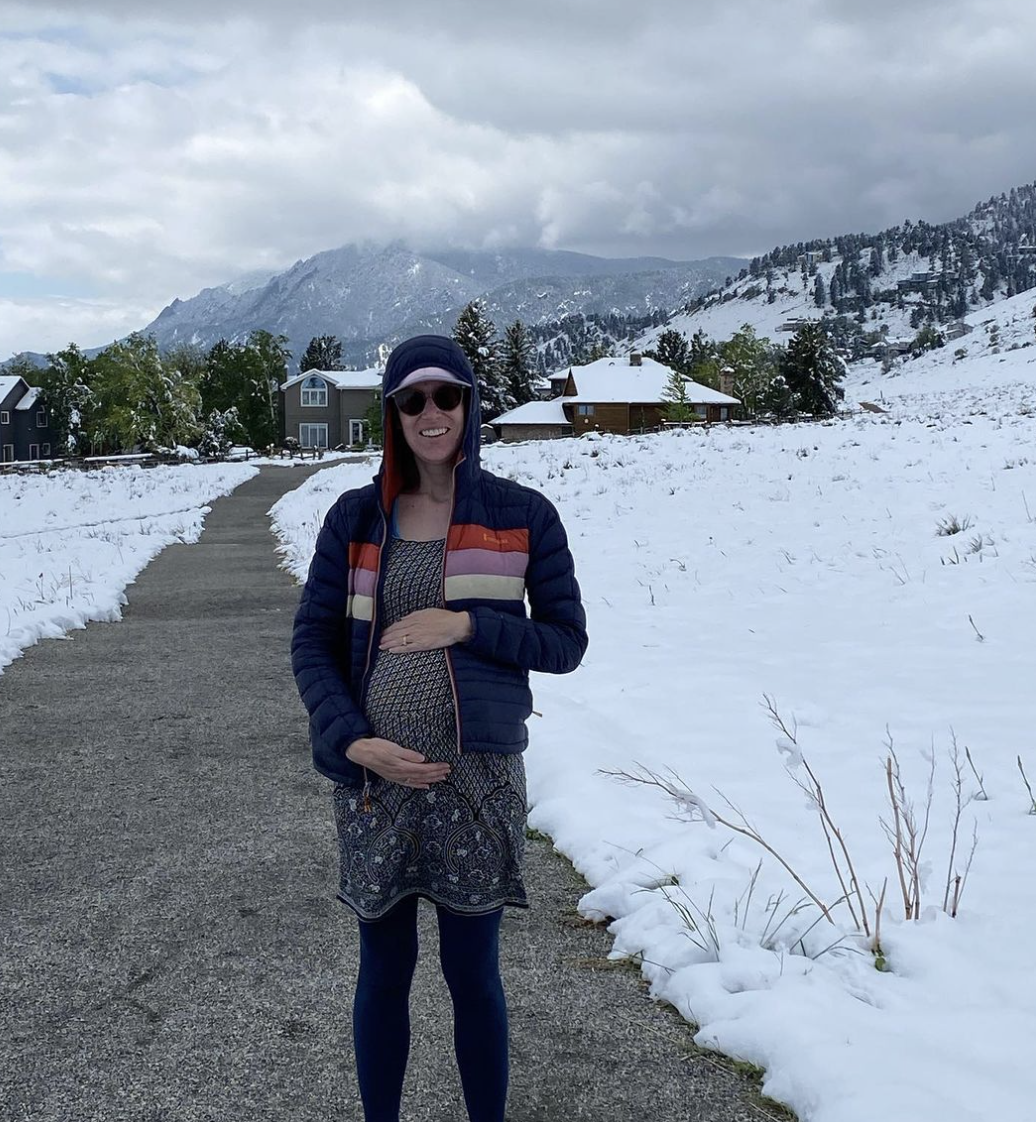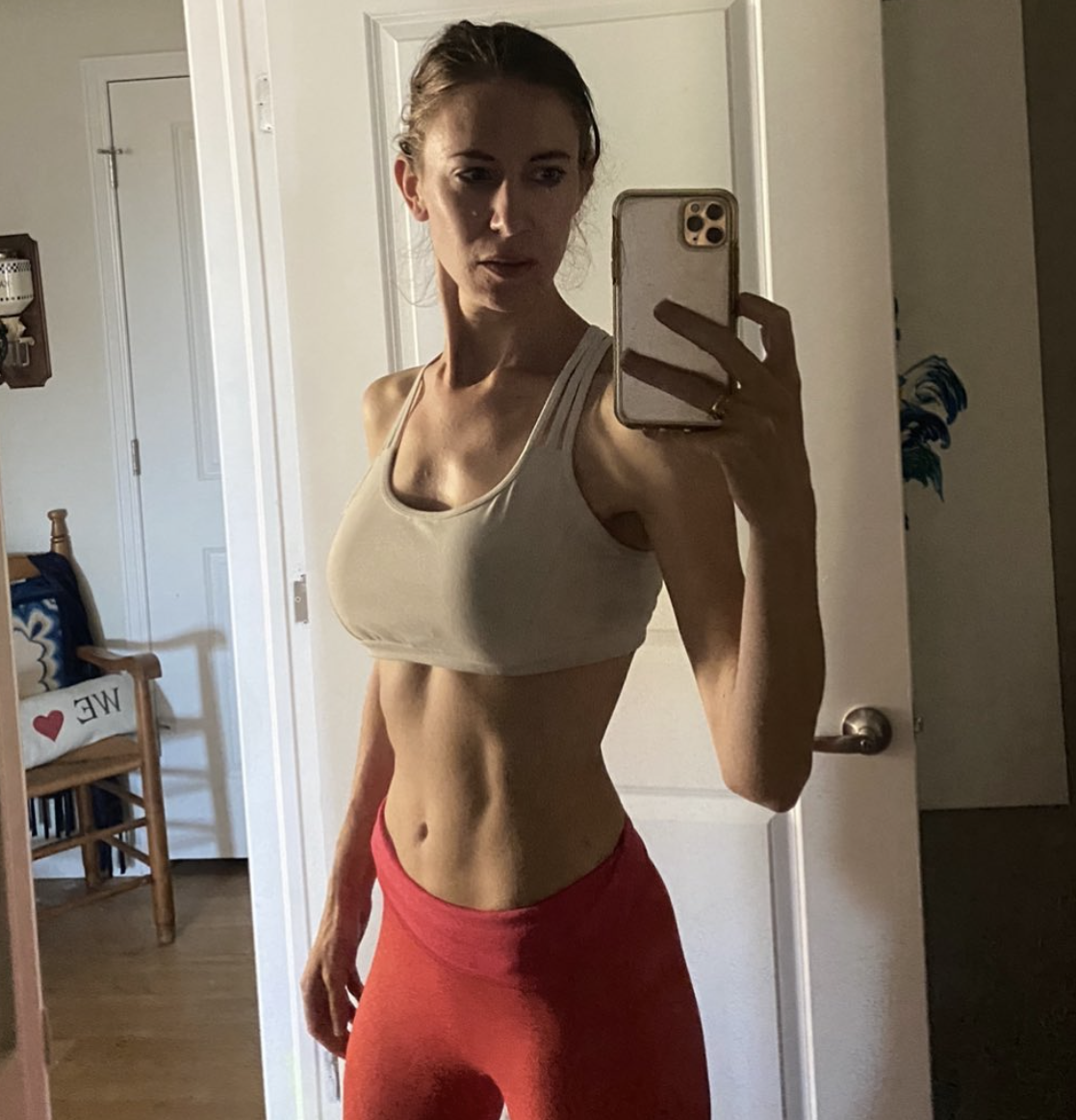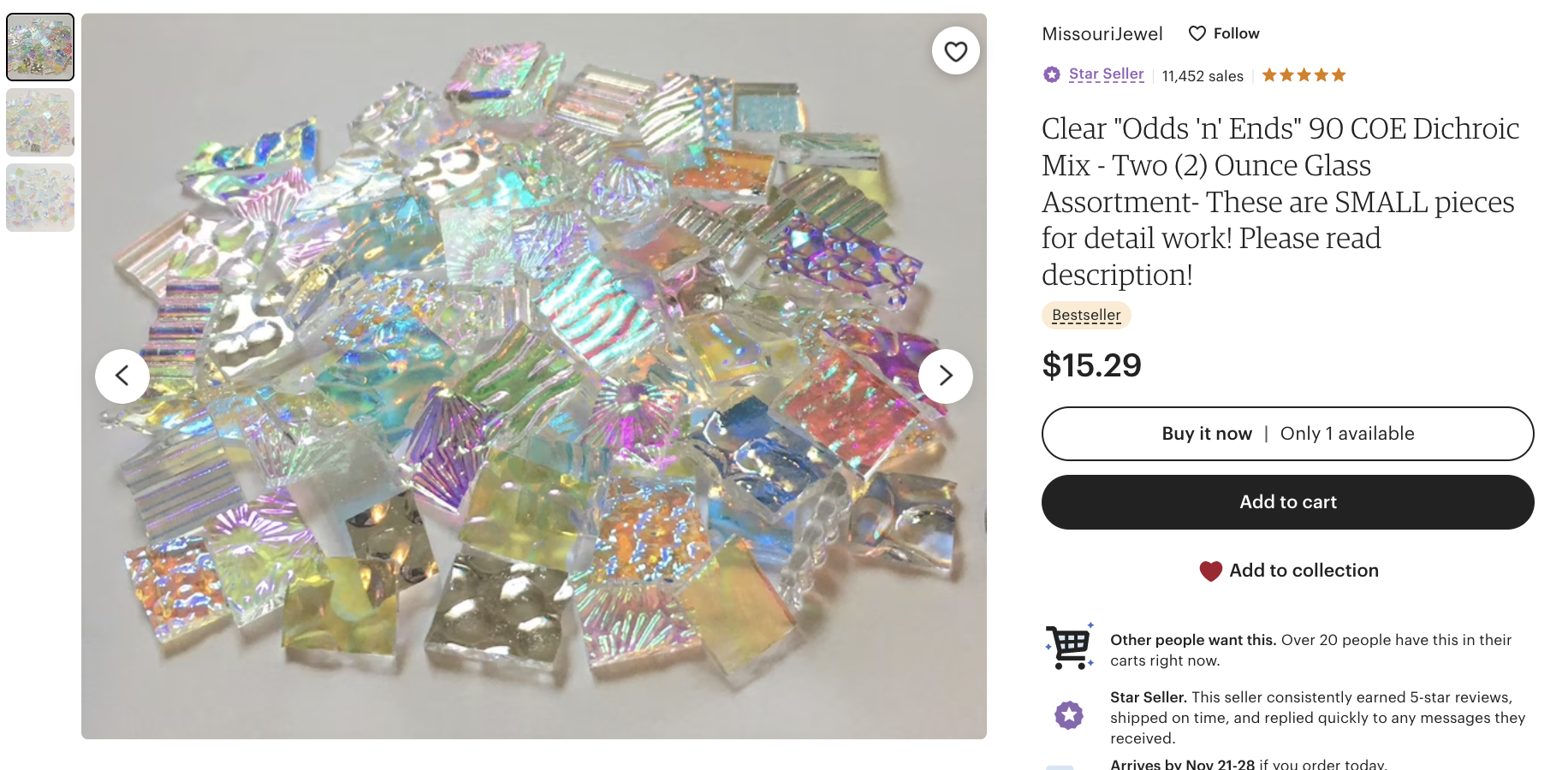In Leadville you can still see some rocks or large boulders that I painted in high school for the Boom Days Drilling competition. This one is my favorite, it was a bright sky blue and now is a powder blue.
Brainard Lake and Long Lake
In 2022 I was lucky to get up to Brainard Lake and go even a bit further to Long Lake. There were many wildflowers and waterfalls to be seen! I loved it up there and I didn’t realize it was about 10000 feet until afterwards. The terrain and flowers remind me quite a bit of the high country around Leadville for this reason.
Painting the Boulder Flatirons
I’ve had fun painting the Boulder flatirons from the large open area of Chautauqua park. In 2021 I painted a few flatiron paintings en plein air in gouache.
I’m using the paintings I made en plein air to create oil paintings in the studio of the flatirons. I also go up to the flatirons every now and then to catch the sunset. It’s the most colorful part of winter.
It’s been fun to do this as a way to get back in to oil. My usual mountain subject is Mt. Elbert over Leadville, and I’m enjoying figuring out the flatirons as painting subjects as well, they are very fun to figure out.
I’ve also painted higher up in Chautauqua park, it can be challenging to hike up with an easel, and it is fun to paint the sunset there, especially in June and July, when large rainclouds appear across the front range.
What is great about this area is that in the summer and the winter, there are many layers to paint. Even the area in front of the rock formations is interesting and full of waves and lines.
Here are a few of my photos of the flatirons in the summer also, it’s fun to see the poppies and various other flowers around Chautauqua.
What I personally like to do with the flatirons is paint them a bit plein air, then take the plein air paintings back to the studio to rework and add details. This way I get the energy of plein air and also the focus I need to really nail down the trees, grass, and edges of everything.
THE Philosophy of Andy Warhol
The book reads similarly to the Diaries of Andy Warhol, which I enjoyed quite a lot. The Diaries are a bit more my style because they’re massive and detailed and almost overwhelming, and what’s fun is you can look up any day, and find out what Andy Warhol was doing that day.
The Philosophy of Andy Warhol is a lot like a compressed episode of the Diaries, where Andy Warhol shops at Macy’s and talks to his friends on the phone for hours, but it is interspersed with overarching quotes or thoughts about life.
I like Andy Warhol a lot, and I think that the reason I like him because he is ready to admit things about life that other people don’t want to talk about, yet his art isn’t ugly or mean. I think that his admissions of beauty and unbeauty are novel or unusual right now in 2023, and may would have been abrupt in the 1960s. There’s something about Andy Warhol’s approach to life that feels refreshingly, maybe even shockingly straightforward. I wouldn’t use the words ‘honest’ or ‘blunt’ so much as ‘direct,’ and this directness doesn’t feel antagonistic or mean. It just ‘is’. Maybe this directness and fearlessness carried into his art, and it’s one reason why he was so successful. In addition to having scores of funny friends and understanding people very, very well, he worked, and eventually people worked with and for him.
What I think is the most true about Andy Warhol is that his ability to understand people led him to being able to predict the future. He seemed to know what people wanted, and because of this, he was able to know how the world worked and how it would work, which led him to his 15 minutes of fame quote. In this book, he also predicts futuristic moments like how much people will love holograms, and the idea of a metaverse or at least an online world or a community that isn’t in person. He does this without thinking of it in terms of computers, which I think is very novel. It feels like he predicted the high speed rail without first knowing about the steam engine.
There are a lot of worthwhile moments in this book, I loved it.
It is possible I already had some presentiment of my future
Book of the New Sun - Page 1
It is possible I already had some presentiment of my future
Mt. Elbert
My latest medium-sized Mt. Elbert painting is done! Here it is:
This was my first larger oil painting I’ve done in about 18 months, since I’ve been avoiding oil paint while pregnant and in my months of breastfeeding.
Never Finished - David Goggins
What I like most about David Goggins is that he keeps challenging the parts of himself that he doesn’t like. In both his first book and Never Finished, he often splits himself into two personas: David, and Goggins, where David is a person to transcend, and Goggins is his transcended ultimate self, his truest, best self.
I think that this approach is good, first of all, because it’s on Goggins’ own terms. Nobody else is pushing him to be the way he is except for him. The split persona approach might work for many people, because it allows all of us to confront the parts of ourselves that we dislike as if they are people who are separate from us. It’s a compartmentalization of the old and new, and parts of ourselves that work well for us vs. parts that do not.
I read Can’t Hurt Me a few years ago. I tend to read many nonfiction books at once, and Can’t Hurt Me felt like someone was finally being real with me and telling me the truth while others were serving up platitudes and embellishments. Maybe ‘truth’ isn’t the right word for it, and neither is ‘accountability’. What DG does in his first book is radical self-confrontation. He hones in on himself and his goals and ends up being a Navy Seal. He continues this in Never Finished in the form of ‘evolutions’ as chapters. Each chapter is biographical and also interspersed with applications. It usually takes the form of a few pages of biography, and a few paragraphs of applications. I personally found this cadence to be useful and worth imitating. The format of a personal anecdote followed with advice or broader application is something I resonate with.
What I like a lot about Never Finished is DG provides a few highlight tools to perform radical self-confrontation. In the first couple chapters, he recommends recording your own voice and also listening to your haters, or reading every comment. I think this is wonderful, because I’ve never heard more discomfort than from people who record their own voice, and also the popular adage is to never read the comments.
Several years ago I was one of those people too who hated the sound of my own voice, and I ended up getting rid of this by listening to myself over and over. And frankly I’m going to read the comments anyways, and DG had some good advice in his book on what to do with those. It’s not what you might expect so I won’t spoil it.
The title of Never Finished is perfect, as Goggins does believe that when most of us say we are doing 100 percent in life and physical feats, we are actually doing about 40 percent. If phoning it in is the most horrible feeling in the world, leaving it all on the field is the best feeling in the world.
The idea of self-leadership that Goggins discusses in this book is another good idea. It was my favorite concept in the whole book. Again I won’t spoil it or summarize, all I will say is this concept, for me, is one of the most important concepts to review and re-read.
Ultimately, I loved this book and I found so much wisdom in it that I plan on re-reading it often. I can’t think of two people on the planet who are more different than me and David Goggins, yet I find his work highly relatable. The one thing we do have in common is Leadville - I grew up there, and Goggins has run the LT 100 at least twice. I’ve never done the hundred, yet, maybe this is the most exciting aspect of Ultrarunning. It’s an equalizer, where people of different backgrounds, ages, and races all run the same trail but each experience is wildly different. DG’s voice is like this - it’s a challenger and an equalizer. It seeks to bring us all up to the same level. I don’t think a book can have a better mission than that.
"All art is quite useless" - Oscar Wilde
What I think Oscar Wilde meant in this quote is that art has no utility, it isn’t a hammer or a horse, it doesn’t help us accomplish tasks or work.
As much as it is fun to rebel against this thought and make a grandiose list of the ways art is useful, I think that ultimately, he’s right.
Art doesn’t have a ‘use’ like a tissue or a shirt or a textbook full of infographics. It’s something else. I can’t say what it does have, but I do have to agree that it has no use.
I think what Jerry Saltz has to say about art being an operating system makes a lot of sense. Maybe the funniest part of this to me is remembering how much computer operating systems are flawed, and have to reboot. But if I think of the word “operating system” and try to forget the way this phrase is used in terms of computers, it does get very close to how art works.
Art is useless. It isn’t used. It operates, yes, but it can’t be applied. It’s something we can use to communicate, but it can’t shelter our feet against rocks like shoes do. Art is useless, but it still works. It performs movements of energy from one area to another. Art threads through our lives in perfect daylight or peripherally. Like a feeling, art can be the most noticeable thing in the world, or something we forget within a moment.
The moment that art has a use, it ceases to be art.
The War of Art - Steven Pressfield
I like this book’s ideas about Resistance and about overcoming Resistance. Resistance, in Pressfield’s world, is a deeply antagonizing force like gravity - it is anything that keeps us from doing what we want to do and what we were meant to do.
I first encountered the idea of Resistance in a Seth Godin book, I now see the idea is at least a bit older than the Godin book that I read. It’s a solid concept about a diffuse entity. I find it useful to identify and even personify the kinds of procrastination that keep artists from working.
Aspects of Pressfield’s beliefs towards discipline that are critical towards certain foods and also sex are a little harsh, as we all need both to keep living and to live day-by-day. I’m all for discipline in most cases but I’m going to keep eating food the way that I usually do, and I think even if you held a gun to my head, I’m not going to percieve my sex life as a distraction from my art.
The book was published in 2002 and doesn’t seem to have been re-editioned or footnoted, because Pressfield casts up an example of fortitude in Lance Armstrong’s accomplishment of winning the Tour de France after having cancer. There’s no mention of Armstrong’s doping admissions. It happens… but anyone reading this book in 2023 probably won’t see Armstrong as a paragon of resilience. I doubt Pressfield does either since he is against drug and alcohol use.
Maybe what is pure about this book is that Pressfield just wants to inspire us to get off our butts - he doesn’t get to the point of asking artists to resist the urge to break the rules in the way Lance Armstrong did. Resistance is so difficult to spy and defeat that it hid within one of Pressfield’s examples, in the form of doping.
That’s enough about Lance Armstrong I guess. With more importance, I appreciate Pressfield’s distinction of the Professional versus all others, where Professionals show up each day despite facing various challenges, where non-professionals seem to give up for any reason.
The page/chapter I felt I resonated with most was “How to be Miserable” which covers how Marines know to be miserable, and they keep moving on despite this, and how artists are similar. Being a person raised by a Marine veteran, this page rang true for me. Sometimes art is hell, and it’s funny how hellish it is. It’s fun to laugh at one’s own failure and keep moving on. I won’t quote the page directly, but if you do read or have read the book you’ll know what page I mean.
What I also like a lot in this book is the idea that art doesn’t come from the artist at all. I’ve never felt comfortable taking credit for most of my work, to the point where I hate signing my paintings. This book helps explain why this happens to me, and millions of other artists out there.
All in all, some parts of this book may make some people a bit mad, and it’s hard to agree with all of it. I do like the more secular and eternal principles here, and when a chapter had something I could relate to, like Marines or being a mother, it did stand out to me as true.
All art is a force of optimism
At the core of every artistic act, artists are saying: “The world would be better if it were this way”
If we are making any kind of art at all - if we are making a handprint turkey or a 30 x 40 inch painting of a river, at the core of this act, we are saying “the world would be better if it were this way”
I think this is why some people are a bit scared of making art. Because, if we make something and it sucks, then we’ve made the world a worse place. This is scary as hell.
Art is about having confidence, it’s about saying “This situation will be better when I take the paint out of these tubes and apply it to a canvas.”
The most incredible thing of all about art is that any of us, right now, could go to Michaels and spend $5 on a canvas and $20 on paint and we could make the best art that has ever been made. Maybe we don’t even have to go to Michaels. Maybe we could gather small stones on the ground, or make footsteps in the snow, and we could make the best art that anyone has seen all year.
All art is a an act of pushing the world to a better iteration of itself. The possibility of art is endless.
Painting Fish
I was lucky to happen across iridescent watercolors. I started to think about painting things that had a natural iridescence. I made a couple confusing landscapes with the iridescents. It didn’t work out because the type of landscape I was painting wasn’t iridescent. (I think snow and auroras would look cool with iridescents, though!)
Finally I realized that some animals were iridescent - hummingbirds, and also, fish and reptiles and beetles could be iridescent.
Not knowing a ton of beetle enthusiasts personally, I figured hummingbirds and fish would be a good place to start with painting iridescent animals.
I’ve painted the following rainbow trout and have had so much fun doing it! I will be moving on to a new type of fish soon.
Boulder Falls
Lately I decided to take a trip to Boulder Falls to see if it would look cool, and it seems the answer is a big YES!
It was difficult to get to the falls since the walkway was so iced over. I should have worn crampons but I made it with my running shoes and holding onto the walkway’s guardrail chain.
I thought about possibly painting the falls but there is no way I could have carried my easel down to the falls without slipping or without crampons. It may be a fun thing to do on another day. For now, what I might do is use the photos to paint the falls from my warm and cozy studio. Though, it would be badass to paint at the falls themselves. It’s always different to paint in life versus from a photo. I think it’s a bit better, too, to paint from life.
Boulder Falls is easy to drive to from Boulder - drive up Boulder Canyon for 9 miles and it’s there.
My Magic Paper Menagerie
This week I worked on some paper art as well as framing my art, including some rainbow trout watercolors.
It has been fun to find frames for my artwork and make pieces that are small as well as medium-sized pieces.
Many of the pieces above were made at the end of 2022, and a few were made in 2023. I’m going to keep track of how much art I make in 2023, in terms of complete collages, drawings, paintings, and other pieces.
So far in 2023 as of January 3rd, I have made 5 pieces
2 dragon collages
1 random collage
2 large oil paintings
I will keep everyone updated in my future posts!
Sketchbook Confessional 2022 - My Year in Art
2022 is coming to an end and it’s time for me to recap what I’ve worked on all year!
The most exciting thing I did in 2022 was become a mom. It was so exciting to learn about Baby Jewell being on his way at the end of 2021. I made Baby Jewell’s first painting in January of 2022 above, of his little ultrasound scan.
In 2022 I made countless paper animal bookmarks. I can’t count how many I made but I think I made about 1000 of these.
I went big with paper art in 2022, I made dozens of pieces of cats, dragons, birds, and other animals.
In 2022 I started studying watercolor and working with it. I had to study it and read books about this medium to understand it. My previous forays into working with watercolor were pretty bad. I learned about paper, colors, and brushes, and after I put in the time to do this, my art was much better.
At the end of 2022 in mid-December, I did a few oil paintings after taking a break from the medium while I was pregnant and breastfeeding.
I was really happy to get back to oil painting even if the way the paints smell is a pain to me. Maybe my mom hormones make me smell it more than I used to, because I am using the same paint I’ve always used! I am not sure.
Earlier in 2022 I also worked a lot with gouache, which I think is a beautiful medium and it doesn’t get enough credit at all!
Finally I am excited to say that I am working on a comic I’ve been wanting to do for a long time. It’s called “Merlin in the West” where Merlin of King Arthur fame finds himself transported to the American Wild West. I can’t wait to work on it more and I can’t wait for you to read it!
I’m not sure how I will publish Merlin in The West but I think I’ll do it online or on the web first. Maybe on the same domain as TiltedSun.com, we will see.
In summary, I made a lot of art in 2022! In total I estimate that I made at least 1300 pieces of art, including the bookmarks, tiny paintings, big paintings, and watercolors on paper. It was a different year for me since I spent the entire year working on being a mom. I think that being a mom has fundamentally changed how I work, but not the nature of my art. I’ve found that I am a bit more organized because time is so critical to manage, as I have less of it. I do think that this limit is helpful, though. I make more art in shorter periods of time than I used to make in longer periods of time. I find that I must make an impact with my time, instead of wait around and let things draw out.
Recovering my Pre-Pregnancy Body
Getting pregnant and having a baby didn’t make me weaker, it made me far stronger than I ever imagined.
I took the image above on September 30th, two months after giving birth to my baby.
I’ve thought about this blog for a few months before releasing it, because I wanted to make sure I figured out the real answer to what helped me bounce back so fast. It ended up being a different reason than I thought.
I’m going to ask everyone reading this blog to perform a radical thinking shift. For me, there was no secret postpartum workout that helped me recover. There wasn’t anything special I did.
What helped me recover my body’s look wasn’t what I did after giving birth.
What counted was what I did before being pregnant and while being pregnant.
I’m very sure that my activity while I was pregnant was what helped me bounce back rapidly.
I hiked a decent amount while I was pregnant because that was what I could do. Running seemed like a bad idea after the first trimester. It was a bit strange because running became so unattractive to me that I couldn’t stand it.
Looking back, I didn’t just hike a little bit, I hiked almost every day. Maybe I even hiked so much it was a bit silly.
Weight before being pregnant: 130
Max weight while pregnant before I gave birth: 175
Weight at 1 week postpartum: 155
Weight at 5 months postpartum: 135
Here is a photo from Sept 21 2021, and a photo from October 19 2022.
I am definitely not AS shredded as I was before pregnancy but I will say I am now a lot stronger. I carry my baby around with me on my walks and hikes and daily life, I build quite a bit of strength rather than anything that even slightly resembles speed.
Other facts about me that are good to know in this context: I’m a bit tall, I’m 5’11. As per 23andMe, I have fast-twitch muscles. (Better for basketball than for my much-loved activities of running and xc skiing). I also haven’t had any alcohol since June of 2020 and consider myself not just California-sober but sober-sober.
I didn’t do anything extreme after birth to get my body back. The highest mileage run that I’ve turned in after giving birth is 6 miles. I ended up finally getting COVID in November too, so I’ve been turning in 2 and 2.5 mile runs ever since then, too.
I would say that my year before getting pregnant was extreme on the exercise side of things. I was running 10-15 miles on some days to train for the Collegiate Peaks Trail Run, which I barely finished in about 8 hours.
I finished, but barely, and very slowly! This is me in the parking lot after finishing the Collegiate Peaks Trail Run 25-miler in May of 2021.
2021 was also the year where I threw my hat into the ring for a modeling contest: Maxim Covergirl. I started it out on a lark and I ended up doing better than I ever dreamed, I finished 5th in the quarter finals and ended up raising about $3000 for Wounded Warriors.
My baby’s birth in 2022 was built on a strong foundation of fitness. Even though I was happy with my running in 2021 and I see myself as pretty fit, it was a tough labor and I pushed for 5 hours to get my baby born, narrowly avoiding what would have been a difficult C-section.
Baby Jewell and I together!
I think the best takeaway from my experience for others, that I would advise if asked, is to be as strong as possible while being pregnant or before being pregnant. I was in the best shape of my life in 2021 and I can’t wait to get back to running 10 miles at a time in 2023. I’m not quite there yet, but I can feel it within my grasp.
Warhammer Winter Wonderland 2022
I had a love-in-first sight experience when I first saw a box featuring a fully painted Lord Aquilor on it at Asgard Games in Houston. I was playing a Commander game with about 7 people and saw Lord Aquilor on a shelf by pure chance, and knew I had to have it somehow.
I’m very easily enchanted by things that, in retrospect, strike me as completely random. However, when it comes to things like Magic the Gathering, DnD, Warhammer, and Pokemon cards, maybe it’s not random at all. Maybe, small and detailed figurines contain a kind of magic, something precious and precise, that I can’t help but love and appreciate. Especially as an artist who makes work at large and small scales.
In 2021 I first had the idea to combine “Christmas Village”-style figurines with Warhammer figurines. I could only walk by the Christmas diorama art at Michael’s so many times before wanting to make a diorama of my own, and I also had some Warhammer figurines that I had been meaning to paint, so I combined the forces of these two worlds to create what I call Warhammer Winter Wonderland, a diorama in my house on my art table.
I’ve decided to do this every year, because it brings me joy to set up little scenarios between Santa and Lord Aquilor, and also because my mom thought it was funny.
Here are photos from Warhammer Winter Wonderland 2022
If you’re so inclined, here is what you need to make your own Warhammer Winter Wonderland!
Warhammer figurines - the sky’s the limit! I used only figurines that I had primed in my Warhammer Winter Wonderland. There’s no reason that any kind of figurine couldn’t be used for this kind of decoration. You’ll notice the figurines in my diorama aren’t painted very much - it’s not for lack of wanting to, I just straight ran out of time!
Snow - I chose cottony/fiberous-style snow for my terrain but you could definitely make other choices for your snow terrain. I found the cottony snow was a bit hard to work with, it can be a bit difficult for me to evenly place figurines with this style of snow. When I make Warhammer Winter Wonderland 2023, I will probably use a different type of snow.
River feature - if you have a bridge in your Winter Wonderland, you might like to use blue paper of different kinds to make a river or lake feature.
Christmas village figurines - I personally picked these up at Michaels. The large buildings are from the brand Lemax. I ordered a few of the other background buildings in July and congratulated myself on my deal-finding ability.
Background drop - for the background of my photos I made a canvas with a thin wash of blue paint for the sky.
Camera - for my photos, I used an iPhone 14 on normal camera mode and also portrait mode.
Doubt is a sign of limits being pushed
Doubters are a sign of success.
When a person starts pushing the limits of human skill and endurance, there are doubters that come along, they'll say things like "Did you really do that?" and that's when we know we are beyond what we thought our limits were.
My insane routine as an average high school athlete in Leadville
I was never the best athlete in school, but, I did do my best.
I was consistently the third or fourth runner on my team, I’d finish something like 25th or 30th overall, and the third in my group of peers who also went to school in Leadville. I was always very average, but I was very happy as a runner and skiier in high school.
For some reason, I had an absolutely insane routine which involved exercising three times a day, with weightlifting in the morning, xc skiing or xc running in the afternoon, and squeezing in some biking at night.
Here is my routine from when I was 16 and 17.
5:30 am - wake up and drive to the gym
6:00 - 7:00 - lift weights
7:00 - 8:00 - jazz band
8:00-3:30 - school
3:30 - 5:15 - xc running or xc skiing
5:30 - drive home + shower + dinner
6:00-7:00 - stationary bike while reading
7:00-9:00 - free time, art, videogames, college prep
9:00 - sleep
Looking back at this routine, it looks absolutely bananas. As a 36 year old, I ask myself… why? Why on earth did I do all of this?
The answer to the ‘why’ question is simpler than it sounds. It would be possible, in a moment like this, to be self-aggrandizing and to take credit for being a total unique person who did all of this completely on her own.
That would be false. The real reason is that I did all of this because I had good influences in my life.
My parents were always doing outdoor activities like skiing and hiking, and the friends I had in high school were also very athletic. Remember when I said I wasn’t the best, and I saw myself as average? It’s because even though Leadville was and still is small, there were still many others who were better than me at everything. That’s why I put in the time. It wasn’t because I wanted to be the best. I knew my friends would always beat me and be faster. I put in the time because I wanted to be the best possible me.
For me, there’s something relaxing about doing my very best. If I do my best, I never feel like I want to go back in time or do something differently. I rest well at night knowing my time was spent perfectly.
This is also why I still pursue art and make art - I think it’s something that I can always do better at. There’s always something interesting to find out, a new discovery, a new place to excel. I may not be the best at it, but I can be better than I was last year. In art, I can be the best possible me. Art and running are interconnected because everyone is running a bit of a different race. There’s no ball or time outs, there’s only a course, and all of us.
What seems to be the same about my life as a teenager and an adult is my habit of using every scrap of time for something. Every moment continues to matter to me. I don’t wake up to lift weights anymore, but I do wake up and lift my baby and carry him all around my place! If I ever have a routine that is more intense than my high school routine, I’ll keep you posted.
Until next time, see you, Space Cowboy…
My Magic Paper Menagerie
As it gets cold out and I take care of my little baby, I’ve used my small scraps of time to create animals out of small scraps of paper.
I created three mountain dragons on three 2 x 2 canvases:
What I enjoyed most about these was making little environments for the dragons - rolling green hills and spiky mountains, along with the occasional cloud and a yellow sun when possible.
These were fun to make, and, I knew I needed some way to ‘seal’ them or to protect the delicate paper from the world. I ended up mounting each canvas on a single board and enclosing the pieces in this frame:
In a way, this is why I started making paper animals in bookmarks, too. I needed some way to protect the tiny collages from the world, and enclosing each piece in a plastic sleeve worked well.
I’ve made so many cat bookmarks I have lost count, and I love it.
I’ve made so many bookmarks I’ve lost count. It’s somewhere in the hundreds, maybe approaching one thousand these days.
To make my paper animals, I paint on either yupo, watercolor paper, handmade recycled fabric paper, or duralar, and I cut the paper out and create an animal from it.
The paint I utilize is either gouache, iulie watercolors, Emily Grace Palettes watercolors, Coliro watercolors, and the occasional swatch of pure acrylic. Sometimes, I will also paint in oil on yupo paper and clip out the oil painting. This is a bit more rare, but I have made animals from it.
Above is my setup with some Himi gouache, iulie watercolors, Emily Grace Palettes, and Coliro watercolors, and some cats that I created from each set of paint.
I’ve also been making large dragons in addition to the tiny dragons.
The large dragons are made from recycled paper made of t-shirts from Two Hands Paperie in Boulder. I love the super-textured feel of this paper and it’s great that it comes from something that would otherwise end up in a landfill.
The dragon pieces are fun because they change colors in different lights. That’s the beauty of using iridescent watercolors - there are delightful color shifts to be found in every corner.
That’s all I got for now! It’s been fun to work on these paper animals throughout all of 2022. Catch you next time!
Starting my journey with Glass Mosaics
Like anyone who loves colorful and shiny things, I’ve always loved stained glass. I find that stained glass is fun to look at no matter what shape or size it may be. Whether it’s an animal-shaped window hanging, or the Sainte-Chapelle in Paris, glass has always been so beautiful to me.
As an artist, however, I probably won’t be able to make my own stained glass pieces any time soon, because there’s so much that goes into it as far as metal, serious scissors, and glass kilns. It looks like I’d need a garage or a whole workshop to really give stained glass a solid go, so, right now, stained glass is not for me.
Yet, not being one to give up on my pursuit of shiny colorful things, I still wanted to find a way to work with glass.
After researching glass mediums for a bit, I found that I could make glass mosaics.
To get started with mosaic making, I was excited to order some Mexican smalti off of Etsy. A search for this revealed a ton of colorful results of scrap glass.
I also ordered some of this iridescent glass from this seller.
Finding so many exciting listings for scrap glass was a happy surprise to me - but maybe it won’t surprise anyone else reading this blog!
Etsy turns out to be an amazing place to find glass mosaic supplies, at least where we are in 2022. Much in the way that I have been able to find home-made watercolors or small-batch watercolors on Etsy, I was also able to find a ton of listings featuring scrap glass, smalti chips, and also stones that could be utilized in mosaics.
While I’m sticking to glass-only and won’t be using stone for the time being in my mosaics, it’s promising to see that if I ever did want to make stone mosaics, many raw stones are to be found on Etsy.
In total, I ordered the smalti, some dichroic glass scraps and some iridescent glass scraps. Upon ordering, I wasn’t sure about exactly what I wanted to make, but I knew I wanted to order these supplies so that I would have the chance to make something. I felt as if some kind of idea was materializing in my head, but I couldn’t make it out quite yet.
I find that sometimes art is like this - sometimes, the medium comes first. Sometimes, the idea comes first. Sometimes, they both arrive together. With my art practice, I find that I often need to have the medium available first, and to start working with the medium, and THEN the ideas come out.
I am not sure if other artists are this way, or if there is a majority of us who have ideas first and then purchase mediums after getting ideas. Or, the other way around. Who knows?
It’s nice to have more supplies rather than less, in my case, but I bet there is a critical mass level of supplies where if I had too many supplies, I would get overwhelmed and not do any art at all!
Also, what may have happened here was that I’ve never worked with glass or done a mosaic before (outside of maybe a craft mosiac in elementary school). So, not really knowing what to do or having a plan, I approached it a bit randomly and indulged a couple impulse purchases based on what made me say “oooh, pretty!” on Etsy.
To cut the glass for my mosaics, I grabbed some glass cutters online on Amazon. I wasn’t sure if these would work out either - the cutters with circular edges turned out to work for cutting the smalti.
At first, cutting the glass or smalti was a bit difficult for me - I was not sure about how hard to squeeze the cutters, or if the glass would fly away or something. After a couple tries and after getting a container to catch the cut pieces, I built confidence in how much I could squeeze the cutter handles and still successfully cut the glass in the way that I wanted.
I think that the practice of cutting the small mosaic pieces really surprised me. Since the cut glass pieces are for mosaic work, and not something that is meant to be exact, it ended up being one of those processes where I could feel myself letting go of expectations of perfection. The glass pieces would cut mostly straight, and sometimes a tad wobbly, but nothing drastically different than what I expected.
I ended up creating the mosaic below. To create an area to place the glass pieces, I made a strip of black heavy gel medium on this bright pink canvas and taped it off. After that, I slowly added my glass pieces to the black gel.
This ended up being very fun! It was a game of carefulness to place the smalti and also the dicroic glass. I was going for a bit of a domino look with the smalti, and with the dicroic glass, I approached it from a more traditional-mosaic angle.
After placing the glass pieces, I removed the tape and I ended up with a pretty strip of color on black. I am really happy with how this turned out!
You might notice there is a little swoop of black gel at the bottom right of the piece above. Fortunately I ended up clipping it from the piece once it was dried, so that it didn’t end up as a distraction.
Finally, I paired this mosaic with another mosaic/texture piece I did:
I liked how these turned out! For my next piece, I think what I will do is more flat mosaic pieces using dichroic glass. I liked how the black gel ended up looking on the pink canvas, and the black gel also helped the dichroic and iridescent glass stand out quite a bit. I was worried about some of the colors of the glass getting lost in the black, but that didn’t end up happening, so it worked out well.
I might try white gel in the future too but I’m not sure how to make it look as good as the black gel.
Thanks for reading my blog about my first glass mosaic! I will keep everyone posted on my next pieces.












